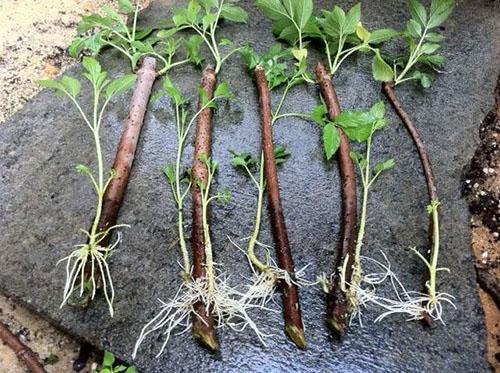Cutting is the best way to propagate blackberries
 Blackberries have already become widespread in Russia. Breeders have bred more than 100 varieties of this crop. Among them there are varieties with thorns, as well as thornless varieties. Large-fruited and frost-resistant blackberry bushes were bred. The blackberry bush bears fruit with black berries. Fruits appear on biennial shoots.
Blackberries have already become widespread in Russia. Breeders have bred more than 100 varieties of this crop. Among them there are varieties with thorns, as well as thornless varieties. Large-fruited and frost-resistant blackberry bushes were bred. The blackberry bush bears fruit with black berries. Fruits appear on biennial shoots.
If a variety purchased on the market or in a nursery pleases you with its harvest, you can propagate it yourself. In this case, black berries are enough not only for fresh consumption, but also for making delicious drinks and aromatic jam.
How to propagate blackberries
Blackberries can be propagated in several ways, but the most effective is summer propagation with green cuttings. In order for the cuttings to take root well, you need to prepare the pots. In August, blackberry lashes are cut to four buds. Each cutting should have three side shoots. The height of each cuttings is from 30 cm to 40 cm. The prepared cuttings are planted in containers with soil. Sandy or sandy soil is well suited for growing blackberries, but the bushes take root in any fertile soil. Blackberries respond well to feeding organic fertilizers.
The root system of the shrub will develop better if magnesium-containing fertilizers are added to the soil.
Preparation of seedlings
For breeding blackberries, pots or two-liter plastic bottles, cut into two parts, are suitable. Drainage holes are made in bottles with an awl.
Use brown plastic bottles. In such bottles, the roots of blackberries will be more comfortable, since dark containers attract less heat from the sun.
The containers are filled with earth and cuttings are planted in them. Next, they dig a hole 5 cm deeper than the container with the handle and put the bottles in them. Pour 2 cm of water into each pit. This is done in order to stimulate root formation. Then the holes are buried and the soil is well watered. After three weeks, the blackberry cuttings will take root. A dense earthen lump forms in the bottles. Thanks to him, the seedling will perfectly transfer the transplant to a permanent place of growth.
After transplanting, the plants are well watered and fertilized, and the blackberry lashes are tied to trellises. In the future, the blackberry bush will need to be looked after: pruning and mulching the plant.